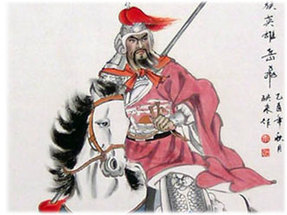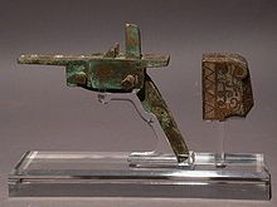Military Power in Ancient China All men aged 23 were eligible for conscription into the military. Conscripted men would undergo 1 year of training in one of the 3 branches, which were army, navy, and cavalry. One could avoid being conscripted if they paid a commutable tax. In times of war, the Emperor would raise militia from the surrounding lands by drafting all eligible men into the army, who were the main source of military power because of how fast they could be alerted, as well as the fact that they were plentiful in number.
The need for a Chinese military was self evident. They had to be able to control their vast lands, and were surrounded by potential enemies. There were also different ethnic groups within China, such as the Qiang and Di, and they were divided and fought for power. The nomadic tribes, especially the Xiongnu, a clan to the North of China, caused the most problems, eventually resulting in the wall of China being built. The Chinese also felt threatened by the usage of cavalry and archery by the nomads, and began to take advantage of horses. They had a specially trained military branch dedicated to cavalry, and began to utilize forms of nomadic clothing while on horseback to maximize maneuverability. They also began to make use of archery techniques, and developed weapons such as the crossbow. They also made use of metals such as iron to make their weapons and armor from. |
- Unit 1
- 1.1.3: Tools and Adaptation>
- 1.3.9 & 1.3.2: New Religions & Geographies of Early Civs.>
- 1.1.2: Humans and Fire>
- 1.3.6: Arts & Record Keeping>
- 1.3.1-1.3.3: Early Culture & Systems of Rule>
- 1.1-1.4 Early Human Innovation>
- 1.2.1-1.2.3: The Climate & The Neolithic Era>
- 1.2.5-1.2.6: Reliable Food Sources & Innovation>
- 1.3.1-1.3.2: Pastoralists & Early Architecture>
- Unit 2
- 2.2.5-2.2.7 Social Hierarchy and Gender Roles>
- 2.2.4 Cities>
- 2.2.2 Orchestration of the Persian and S. Asian Empires>
- 2.2.2 Orchestration of Rome and China>
- 2.2.1: Growth of Empires & States>
- 2.1.6 Cultures Of Second Wave Civilizations>
- 2.1.1: Religions as a Bonding Force>
- 2.1.4 Buddhism and Hinduism Impact on Gender Roles>
- 2.1.2 The Emergence of Religions>
- Unit 3
- 3.1.1 Third Wave Global Trade Routes>
- 3.1.2 The Impact of trade on emerging trading cities>
- 3.1.3. Spread of Islam Through Afro-Eurasia>
- 3.1.4 Inter-Regional Travelers >
- 3.1.5. Cultural Interactions and Art>
- 3.1.6: The Impact of Newly Spread Technologies and Scientific Knowledge>
- 3.1.7 Inter-Regional Conflicts>
- Unit 4
- 4.1.1. - Influence of Tools Upon Transoceanic Trade>
- 4.1.2: Maritime Reconnaissance>
- 4.1.3 World Economies>
- 4.1.4 The Colossal Impact of the Colombian Exchange>
- 4.1.5 Government and the Arts>
- 4.2.3 Forced Migration of Africans Cause and Effect>
- 4.3.2 Impact of Technology on state consolidation and imperial expansion>
- Unit 5
- Unit 6


